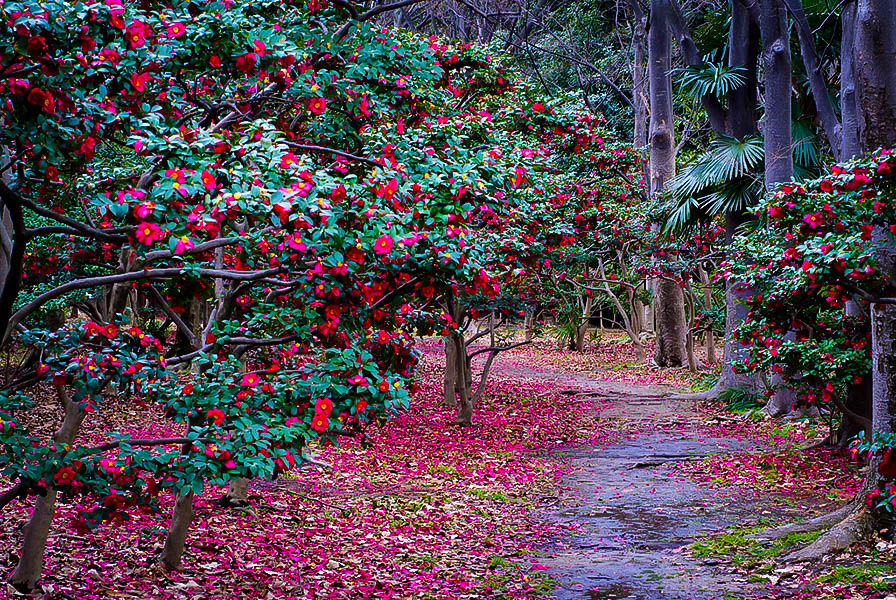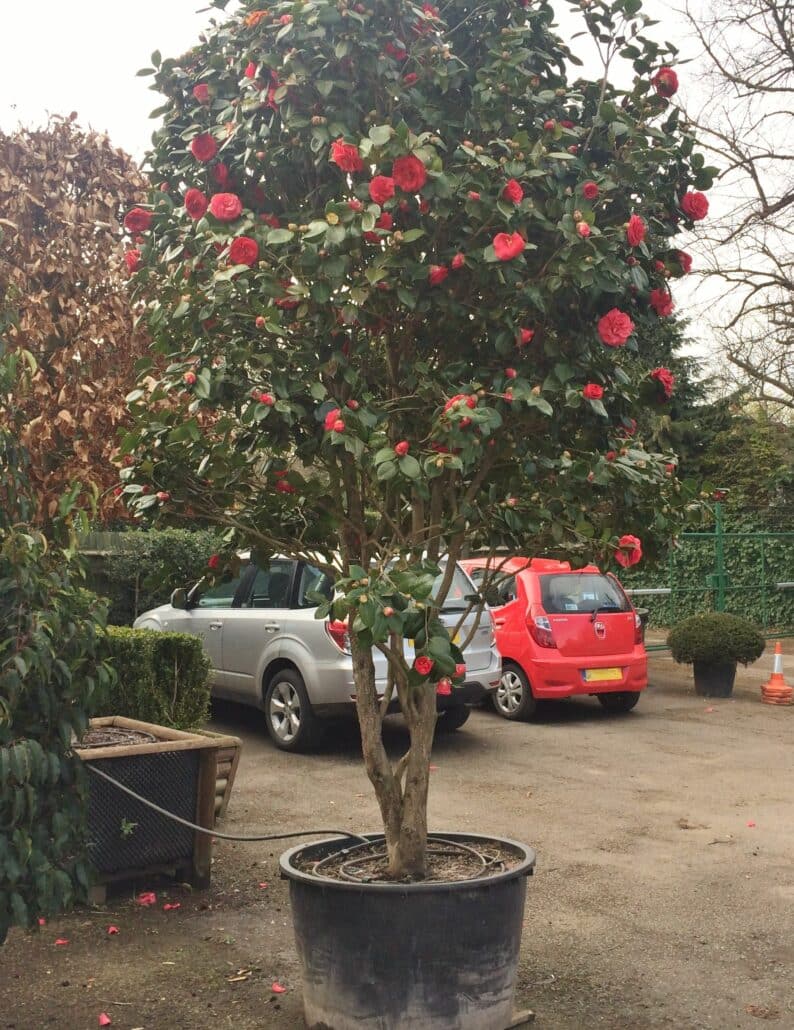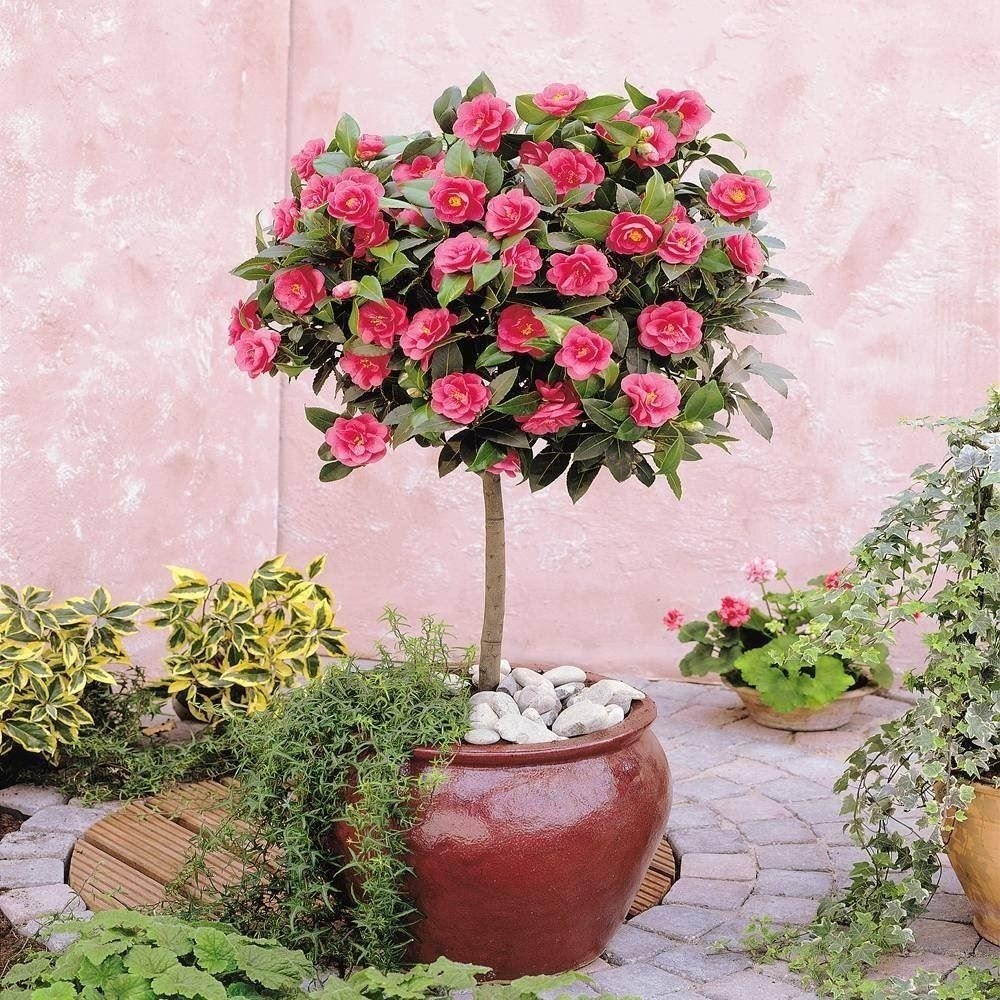Tree Form Camellia
Tree Form Camellia - Web there are six different bloom forms in the camellia genus, and this is something to consider when selecting a species that you prefer or a certain cultivar, particularly if your motivation for planting is to provide pollinator forage sources. When planted in the home garden, these plants can live for more than one hundred years, and become an annually anticipated. Where and how to plant camellias camellia care tips how to grow camellias in pots this care guide offers everything you need to know to grow camellias confidently. The beautiful clusters of blooms usually appear in late winter and stay through the spring. Web we offer a huge selection of large growing camellia varieties that can be easily trained to form an attractive evergreen tree. As your camellia grows taller simply remove lower branches to desired height and you end up with a magnificent flowering tree that is perfect for use as a focal point specimen in the landscape. It is slightly resistant to deer browsing. Web shop the best selection of camellia trees and plants online. One row of not over 8 petals and having conspicuous stamens. The tree form of camellia is prized for its stunning blooms and can add a touch of elegance to any garden or landscape.
One row of not over 8 petals and having conspicuous stamens. [1] they are found in tropical and subtropical areas in eastern and southern asia, from the himalayas east to japan and indonesia. Camellia flower forms are divided into six categories: Where it is reliably hardy (zones 7 to 9), the camellia is a very popular plant that is used in much the same way that northern gardeners use peonies. When to prune for tree form regardless of the type camellia, pruning to tree form should be done in late winter. Web creating a camellia bonsai is an art form, requiring a skilled hand and a deep understanding of the tree’s needs. Filling the air with a traditional rose fragrance, the high fragrance camellia is ideal for use as a tree form specimen in home foundation plantings and outdoor living spaces. It has a spread of 6 to 10 feet. Each form features a specific petal arrangement and number of petals. One or more rows of large outer petals lying flat or undulating;
Web best uses for camellia shrubs and trees. Screenings and hedges of camellias would need to be pruned for their specific purpose within the landscape. Web in the landscape, camellia works well as an accent plant, a privacy hedge, or a tall foundation planting. Web camellia japonica, known as common camellia, or japanese camellia, is a species of camellia, a flowering plant genus in the family theaceae. Web japanese camellia is an evergreen woody shrub or small tree in the theaceae (tea) family. Web camellia (camellia spp.) grows naturally as a small to medium shrub, but is often pruned and trained as an espalier or tree form. Georg joseph kamel was the botanist first to describe the camellia as he explored the island of luzon, where it is native. From shaping the tree’s elegant silhouette to fostering its health, each step demands unwavering dedication and respect for the natural world. How to prune a camellia tree There are more than 220 described species.
Kanjiro Camellias For Sale Online The Tree Center™
Each form features a specific petal arrangement and number of petals. What's the difference between camellia japonica and camellia sasanqua? Web camellia (pronounced / kəˈmɛliə / [2] or / kəˈmiːliə / [3]) is a genus of flowering plants in the family theaceae. Web tree type this shrub is considered both an evergreen shrub and a flowering shrub. Camellia japonica is.
danger garden BuhBye Camellia
There are more than 220 described species. Camellia flower forms are divided into six categories: Web camellia, genus of about 250 species of east asian evergreen shrubs and trees belonging to the tea family (theaceae), most notable for a few ornamental flowering species and for camellia sinensis (sometimes called thea sinensis), the source of tea. In this video, we give.
Camellia Plant of the Month Beneath the Triune Moon
Bloom time varies in camellia shrubs depending on the species. Native to china, korea, and parts of japan, it has become a southern gardening favorite. It is sometimes called japonica. The tree form of camellia is prized for its stunning blooms and can add a touch of elegance to any garden or landscape. Web camellia, genus of about 250 species.
pictures of camellias in the yard Google Search Rose garden
Web japanese camellia is an evergreen woody shrub or small tree in the theaceae (tea) family. Japonica in cultivation, with many colors and forms of flowers. One or more rows of large outer petals lying flat or undulating; There are more than 220 described species. Web tree type this shrub is considered both an evergreen shrub and a flowering shrub.
Camellia sasanqua 'White Doves' ('MineNoYuki') ('Snow On The Mountain
From shaping the tree’s elegant silhouette to fostering its health, each step demands unwavering dedication and respect for the natural world. One or more rows of large outer petals lying flat or undulating; It is slightly resistant to deer browsing. How to prune a camellia tree Web specific plant objectives require specific pruning techniques.
Camellia japonica Rosa Perfecta (Camellia) Practicality Brown
Each form features a specific petal arrangement and number of petals. There are six types of blooms: Georg joseph kamel was the botanist first to describe the camellia as he explored the island of luzon, where it is native. How to prune a camellia tree Growth rate this shrub grows at a slow rate, with height increases of less than.
Camellia Tree Standard Pink Flowering Spring Festival
The center a convex mass of intermingled petaloids. Web specific plant objectives require specific pruning techniques. Camellia japonica is an evergreen tree that can reach heights of up to 20 feet tall. Web creating a camellia bonsai is an art form, requiring a skilled hand and a deep understanding of the tree’s needs. As your camellia grows taller simply remove.
Pin by Lori Sims on Camellia Flowers... Camellia tree, Flowering
What's the difference between camellia japonica and camellia sasanqua? Leaves are 1 to 3 inches long. Camellia japonica is an evergreen tree that can reach heights of up to 20 feet tall. As your camellia grows taller simply remove lower branches to desired height and you end up with a magnificent flowering tree that is perfect for use as a.
Camellia sasanqua (spring bloom, tree form) fragrant flowers
Web camellia (pronounced / kəˈmɛliə / [2] or / kəˈmiːliə / [3]) is a genus of flowering plants in the family theaceae. The tree form of camellia is prized for its stunning blooms and can add a touch of elegance to any garden or landscape. 1.2k views 2 years ago #floweringshrub. When planted in the home garden, these plants can.
Buy High Fragrance Camellia Tree FREE SHIPPING 3 Gallon Size Pots
When planted in the home garden, these plants can live for more than one hundred years, and become an annually anticipated. How to prune a camellia tree Web creating a camellia bonsai is an art form, requiring a skilled hand and a deep understanding of the tree’s needs. In this video, we give you insight on one of our favorite.
Web Etymology Of The Camellia Name.
Native to china, korea, and parts of japan, it has become a southern gardening favorite. There are thousands of cultivars of c. Japonica in cultivation, with many colors and forms of flowers. Web camellia, genus of about 250 species of east asian evergreen shrubs and trees belonging to the tea family (theaceae), most notable for a few ornamental flowering species and for camellia sinensis (sometimes called thea sinensis), the source of tea.
Web Japanese Camellia Is An Evergreen Woody Shrub Or Small Tree In The Theaceae (Tea) Family.
If a camellia is being trained as an espalier, it would need to be pruned differently than if it were being grown as a tree form. Web in the landscape, camellia works well as an accent plant, a privacy hedge, or a tall foundation planting. Bloom time varies in camellia shrubs depending on the species. It is sometimes called japonica.
The Beautiful Clusters Of Blooms Usually Appear In Late Winter And Stay Through The Spring.
Carl linnaeus named the genus after him when developing the modern form of botanical taxonomy still used today. Leaves are 1 to 3 inches long. What's the difference between camellia japonica and camellia sasanqua? The center a convex mass of intermingled petaloids.
Leaves Are Evergreen, Glossy, And Leathery.
Web tree type this shrub is considered both an evergreen shrub and a flowering shrub. Web common japanese camellia (camellia japonica) is a broadleaved, evergreen shrub, which may grow to a height of 25 feet, but more often to 6 to 12 feet. The tree form of camellia is prized for its stunning blooms and can add a touch of elegance to any garden or landscape. [1] they are found in tropical and subtropical areas in eastern and southern asia, from the himalayas east to japan and indonesia.








